Evaluating the Functioning Mechanisms of ‘TANK Systems’ in Peri-Urban Areas of Chennai, India—Land Use Change as the Determinant
Abstract
1. Introduction
- The first line of enquiry was related to the existence of the components and interrelationships of the community management system under the context of change in agricultural land use. This line of enquiry was conducted to evaluate the possibility of reviving community management.
- The second line of the enquiry was related to the current management system. This line of enquiry was conducted to evaluate the effectiveness of the current management system by the government.
2. Materials and Methods
2.1. Study Area
2.2. Data Sources
2.3. Data Processing
2.4. Analysis Methods
- Compare the land use map of 2016 with 1986.
- Apply buffer analysis in GIS using ARC map buffer tool for a distance of 150 and 250 meters.
- Identify the number of plots of common land plots (related to water storage, conveyance, and protective areas) changed into other land uses.
- Trace for the changed common land plots, the change in the land use of the surrounding plots and the common land plot in the previous sets of data (1986 (base year data), (1986–1996) and (1996–2006).
- Identify the trajectories of change.
3. Results
3.1. Trends of Land Use Change
3.2. Relationship between Change in Agricultural Land Use and Change in the Land Use of Common Lands
3.2.1. Correlation
3.2.2. Spatial Pattern of Change
3.2.3. Trajectories of Change
- The predominant trajectory of change in both cases is Paddy to fallow→conversion of common lands.
- The change in the common lands is preceded by a change in the agricultural land from paddy.
- The patterns of land use change in the common lands reflect the land use change of the surrounding agricultural lands. In case 2, with less intensive developmental pressures, the land use of common lands has changed to paddy and plantation in the water conveyance areas. The protective area plots that have changed to residential were located nearby the traditional residential areas of the village and also in zones where the agricultural land has been converted to vacant plots.
- In case 1, the instances of changes were similarly related to the land use of surrounding plots, i.e., common lands were converted into institutional when the surrounding land use of the plots had already been converted to institutional. This relationship indicates that the encroachment of the common land is by the surrounding plot owners, which is to be expected. It is clear from this observation that the encroachment of the common land is due more from proximity causes.
3.3. Relationship between Change in Agricultural Land Use and the Functioning Mechanisms of Community Management
4. Discussions
4.1. Role of Land Use Change as a Determinant in the Evaluation and Selection of the Water Management System
4.2. With Change in the Agricultural Land Use the Functioning Mechanisms of both Community Management and State Control are Ineffective
Author Contributions
Funding
Acknowledgments
Conflicts of Interest
Appendix A
Appendix A.1. Questionnaire used for the Structured Interview and format for the collection of Data about Tanks to be Collected at Village Level
- Is there any irrigation or other schemes for bringing/transfer of water operational here? (for example—Telugu Ganga scheme)
- Tank memoirs for this area available? If so for how many years back? Historical data?
- Tanks in the village—List and categories—P.W.D or Panchayat or Private?
Appendix A.2. For Each Tank
- Name of Tank
- Control agency
- Catchment area of the tank: total area and location
- Purpose of Tank—If Irrigation or others.
- For Tanks used for irrigation: Is it still used for irrigation—If yes questions in section a, if not question in section b.
- Section A:
- i: Ayacut area (current and historical data)
- ii: Sluice and distribution Channels details:
- iii: Who maintains channels and sluices?
- iv: Who takes care of distribution? Opening of sluices etc?
- V: Any Tank user associations present? If so, what are their activities?
- Section B:
- i: Was it used for irrigation before?
- ii: if yes till when and why isn’t it used for irrigation now?
- iii: What is the purpose of the tank now?
- For Tanks used for other purposes:
- i: What is the purpose of the tank?
- Ii: was it used for other purposes before?
- What are the activities carried out by the side of the tanks/in tank bed/in bund by the people?
- Routine:
- Religious
- Communal
- Recreational
- What is the source of water supplied to households? How is it distributed?
- Are there any products collected from the tank and its surroundings?
- Fruits/fodder/wood from Trees:
- Grass cutting/Grazing
- Roofing material
- Silt from tank bed
- Clay from the tank bed:
- Others:
Appendix B
| No. | Aspect | Criteria | Score |
|---|---|---|---|
| 1. | Water Storage area | Water storage area not changed in the last decade | 1 |
| Water storage area partly reduced due to conversion for other purposes. A reduction in area of <50% was included in this category. | 0.5 | ||
| Water storage area completely converted for other purposes/Water storage area reduced by more than 50% | 0 | ||
| 2. | Status of the channel network connected to the tank | Clear | 1 |
| Area reduced | 0.5 | ||
| Obstructions | 0.5 | ||
| Blocked | 0.5 | ||
| Filled in | 0 | ||
| 3. | Bund with its vegetation | Present on all three sides | 1 |
| Partly present | 0.5 | ||
| Damaged/not present | 0 | ||
| 4. | Foreshore vegetation | Wooded | 1 |
| Shrubs | 0.5 | ||
| Scrub | 0.5 | ||
| Grass/Ground cover | 0.25 | ||
| No vegetation | 0 | ||
| 5. | Common grazing land | Present | 1 |
| Part of the area existing | 0.5 | ||
| Occupied for other purposes | 0 | ||
| 6. | Social and recreational | Frequent activity | 1 |
| Occasional activity | 0.5 | ||
| No activity | 0 | ||
| 7. | Usage of the tank water | For original purpose | 1 |
| Changed to lower purposes (e.g., drinking to washing/cleaning) | 0.5 | ||
| Not used/not usable | 0 | ||
| 8. | Extraction of products | For Revenue (fees collected for extraction of products) | 1 |
| For Personal purposes | 0.5 | ||
| No extraction | 0 |
Appendix C
| ID of Changed Plots | Land Use of Surrounding Agricultural Land | Year | Land Use of Common Land | Trajectory |
|---|---|---|---|---|
| Water Storage areas | ||||
| WS1 | Paddy, Road | 1986 | WS | Paddy to fallow → WS to residential |
| Fallow | 1986–1996 | To residential | ||
| Vacant plot | 1996–2006 | Residential | ||
| Vacant plot | 2006–2016 | Residential | ||
| WS2 | Fallow, Paddy | 1986 | Plantation | Fallow to institutional → WS to Plantation to institutional |
| Fallow, to fallow | 1986–1996 | Plantation | ||
| To plantation, to institutional | 1996–2006 | Plantation | ||
| To others, Institutional | 2006–2016 | Institutional | ||
| WS3 | Paddy, plantation, residential | 1986 | Paddy | Paddy + Plantation+ Residential→WS to paddy to plantation |
| Paddy, To fallow, residential | 1986–1996 | Plantation | ||
| Paddy, fallow, residential | 1996–2006 | Plantation | ||
| Paddy, fallow, residential | 2006–2016 | Plantation | ||
| WS4 | Paddy, plantation | 1986 | Paddy | Paddy to fallow → WS to paddy |
| To fallow, plantation | 1986–1996 | Paddy | ||
| Fallow, plantation | 1996–2006 | Paddy | ||
| Fallow, plantation | 2006–2016 | Paddy | ||
| WS5 | Paddy | 1986 | WS | Fallow to vacant plot → WS to residential |
| To fallow | 1986–1996 | WS | ||
| To vacant plot | 1996–2006 | Residential | ||
| Vacant plot | 2006–2016 | Residential | ||
| Water Conveyance areas | ||||
| WC1 | Fallow | 1986 | WC | Fallow to vacant plot → WC to paddy |
| To vacant plot | 1986–1996 | Paddy | ||
| Vacant plot | 1996–2006 | Paddy | ||
| Vacant plot | 2006–2016 | Paddy | ||
| WC2 | Fallow | 1986 | Others | Fallow → WC to others |
| Fallow | 1986–1996 | Others | ||
| To industrial | 1996–2006 | Others | ||
| Industrial | 2006–2016 | Others | ||
| Land use of Surrounding agricultural land | Year | Land use of common land | Trajectory | |
| WC3 | Fallow | 1986 | Paddy | Fallow → WC to Paddy |
| Fallow | 1986–1996 | Paddy | ||
| To industrial | 1996–2006 | Paddy | ||
| Industrial | 2006–2016 | Others | ||
| WC4 | Fallow | 1986 | WC | Fallow to institutional → WC to Plantation to others |
| Fallow | 1986–1996 | WC | ||
| To industrial | 1996–2006 | To plantation | ||
| Industrial | 2006–2016 | To others | ||
| WC5 | Fallow, paddy | 1986 | Paddy | Fallow → WC to Paddy |
| Fallow, to fallow | 1986–1996 | Paddy | ||
| To plantation, to institutional | 1996–2006 | Paddy | ||
| plantation, institutional | 2006–2016 | To institutional | ||
| WC6 | Paddy | 1986 | Paddy | Paddy → WC to Paddy |
| To fallow | 1986–1996 | Paddy | ||
| To plantation, to institutional | 1996–2006 | Paddy | ||
| plantation, institutional | 2006–2016 | To institutional | ||
| WC7 | Paddy | 1986 | WC | Fallow to plantation, others → WC to institutional |
| To fallow | 1986–1996 | WC | ||
| To plantation, to others | 1996–2006 | To Institutional | ||
| plantation, others | 2006–2016 | Institutional | ||
| WC8 | Paddy | 1986 | WC | Fallow to plantation, institutional → WC to paddy to institutional |
| To fallow | 1986–1996 | WC | ||
| To plantation, to institutional | 1996–2006 | To paddy | ||
| Institutional | 2006–2016 | To institutional | ||
| WC9 | Paddy | 1986 | WC | Fallow to institutional to others → WC to institutional |
| To fallow | 1986–1996 | WC | ||
| To institutional | 1996–2006 | To Institutional | ||
| Institutional, to others | 2006–2016 | Institutional | ||
| WC10 | Paddy, Fallow | 1986 | WC | Paddy, fallow → WC to Paddy |
| Paddy, Fallow | 1986–1996 | WC | ||
| Paddy, Fallow, to plantation | 1996–2006 | WC | ||
| Paddy, Fallow, plantation | 2006–2016 | to road | ||
| WC11 | Plantation, paddy | 1986 | Industrial | Plantation, paddy → WC to industrial to plantation |
| Fallow, paddy | 1986–1996 | Industrial | ||
| Fallow, to plantation | 1996–2006 | Plantation | ||
| Fallow, plantation | 2006–2016 | Plantation | ||
| Protective Areas | ||||
| PR1 | Paddy, fallow, plantation | 1986 | PR | Fallow to institutional→ PR to plantation |
| To fallow, fallow, plantation | 1986–1996 | PR | ||
| To institutional, fallow, plantation | 1996–2006 | Plantation | ||
| To institutional, fallow, to industrial | 2006–2016 | Plantation | ||
| Land use of Surrounding agricultural land | Year | Land use of common land | Trajectory | |
| Water Conveyance areas | ||||
| WC1 | Paddy | 1986 | Paddy | Paddy to Fallow → WC to paddy to WC to fallow |
| Paddy | 1986–1996 | WC | ||
| To fallow | 1996–2006 | WC | ||
| Fallow | 2006–2016 | Fallow | ||
| WC2 | Paddy | 1986 | Paddy | Paddy → WC to paddy |
| Paddy | 1986–1996 | Paddy | ||
| To fallow, paddy | 1996–2006 | Paddy | ||
| Fallow, paddy | 2006–2016 | Paddy | ||
| WC3 | Residential, paddy | 1986 | Residential | Residential, paddy → WC to Residential |
| Residential, fallow | 1986–1996 | Residential | ||
| Residential, fallow | 1996–2006 | Residential | ||
| Residential, fallow | 2006–2016 | Residential | ||
| WC4 | Paddy | 1986 | Paddy | Paddy to plantation → WC to Paddy to plantation |
| To Plantation, paddy | 1986–1996 | To plantation | ||
| Plantation, paddy | 1996–2006 | Plantation | ||
| Plantation, to plantation | 2006–2016 | Plantation | ||
| Protective Areas | ||||
| PR1 | Paddy | 1986 | PR | Paddy to fallow, vacant plot → PR to residential |
| To fallow, vacant plot | 1986–1996 | To residential | ||
| Fallow, vacant plot | 1996–2006 | Residential | ||
| Fallow, vacant plot | 2006–2016 | Residential | ||
| PR2 | Paddy | 1986 | PR | Paddy to fallow, vacant plot → PR to residential |
| To fallow, vacant plot | 1986–1996 | To residential | ||
| Fallow, vacant plot | 1996–2006 | Residential | ||
| Fallow, vacant plot | 2006–2016 | Residential | ||
| PR3 | Paddy | 1986 | PR | Paddy to fallow, vacant plot → PR to residential |
| To fallow, vacant plot | 1986–1996 | To residential | ||
| Fallow, vacant plot | 1996–2006 | Residential | ||
| Fallow, vacant plot | 2006–2016 | Residential | ||
| PR4 | Paddy | 1986 | PR | Paddy to fallow, vacant plot → PR to residential |
| To fallow, vacant plot | 1986–1996 | PR | ||
| Fallow, vacant plot | 1996–2006 | To residential | ||
| To vacant plot | 2006–2016 | Residential | ||
| PR5 | Paddy | 1986 | PR | Paddy to fallow, vacant plot → PR to residential |
| To fallow, vacant plot | 1986–1996 | PR | ||
| Fallow, vacant plot | 1996–2006 | To residential | ||
| To vacant plot | 2006–2016 | Residential | ||
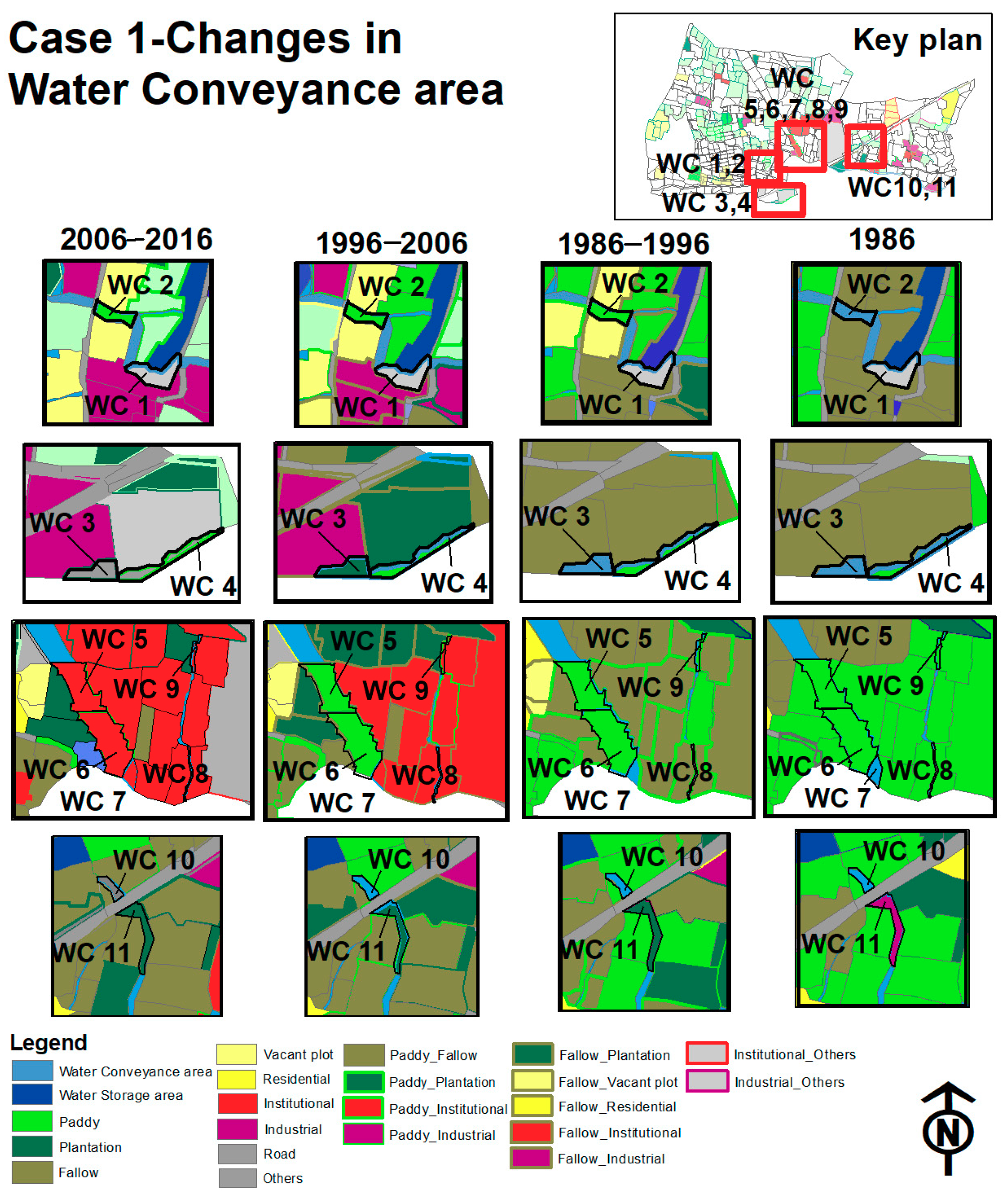

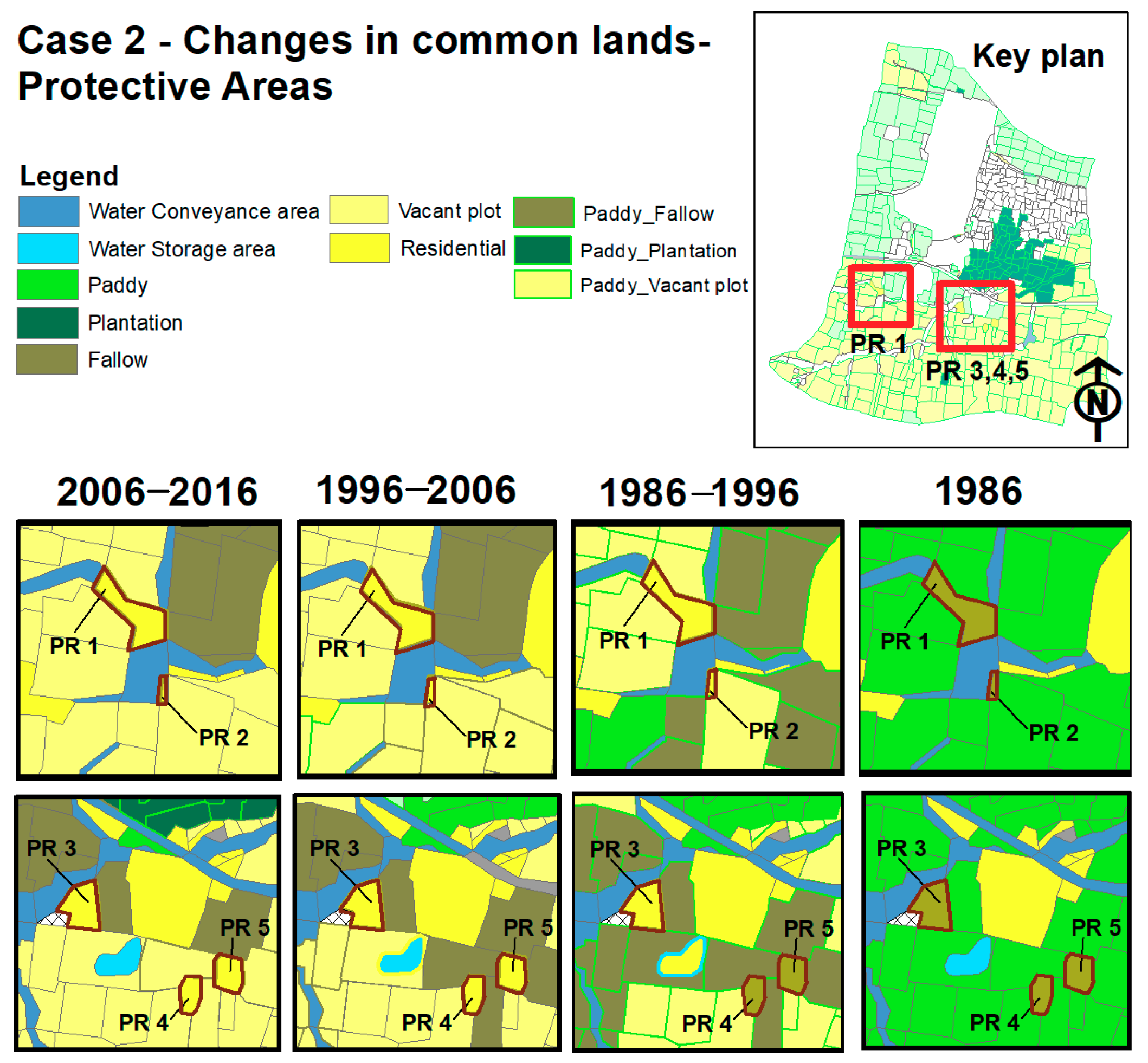
Appendix D
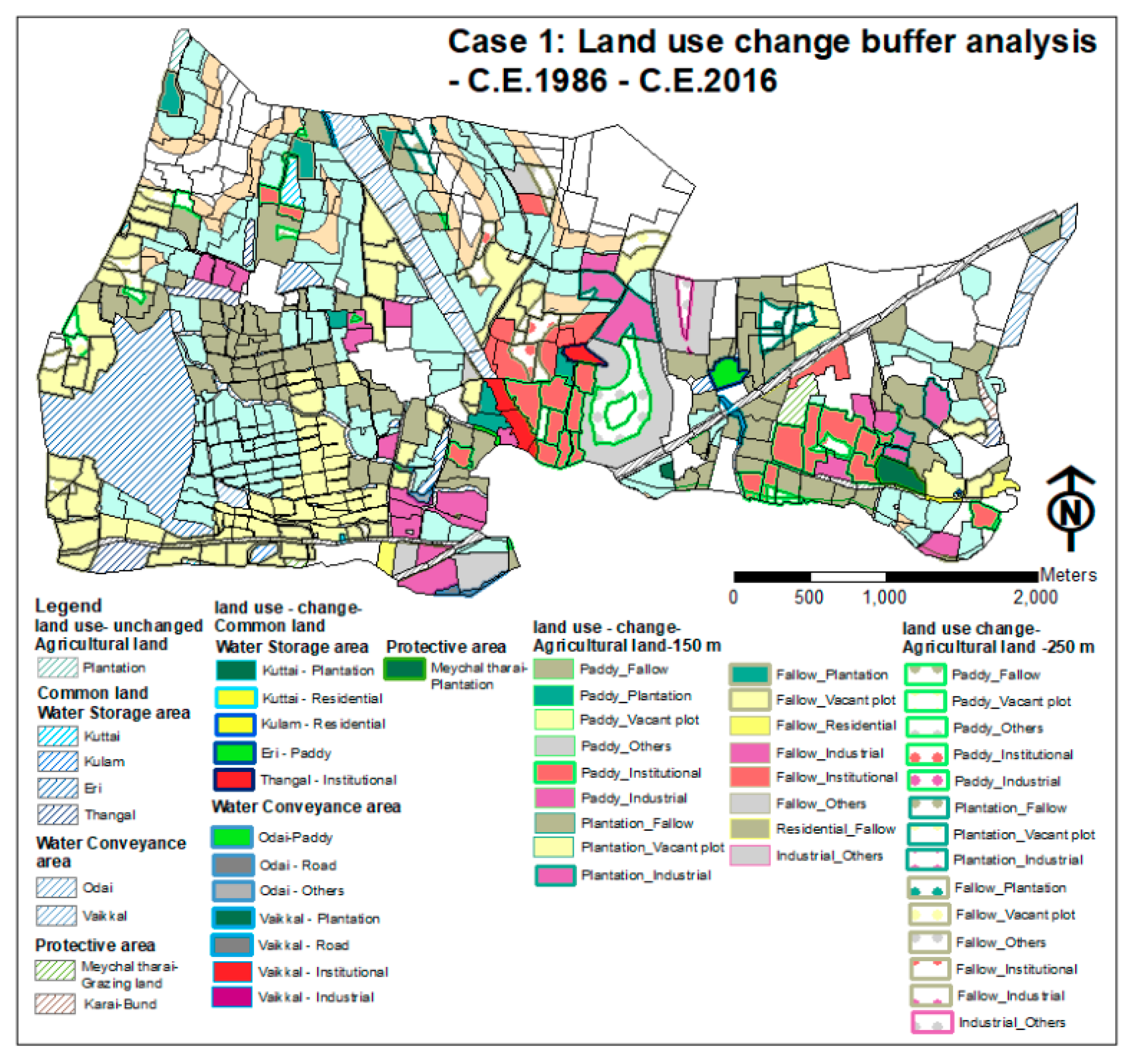
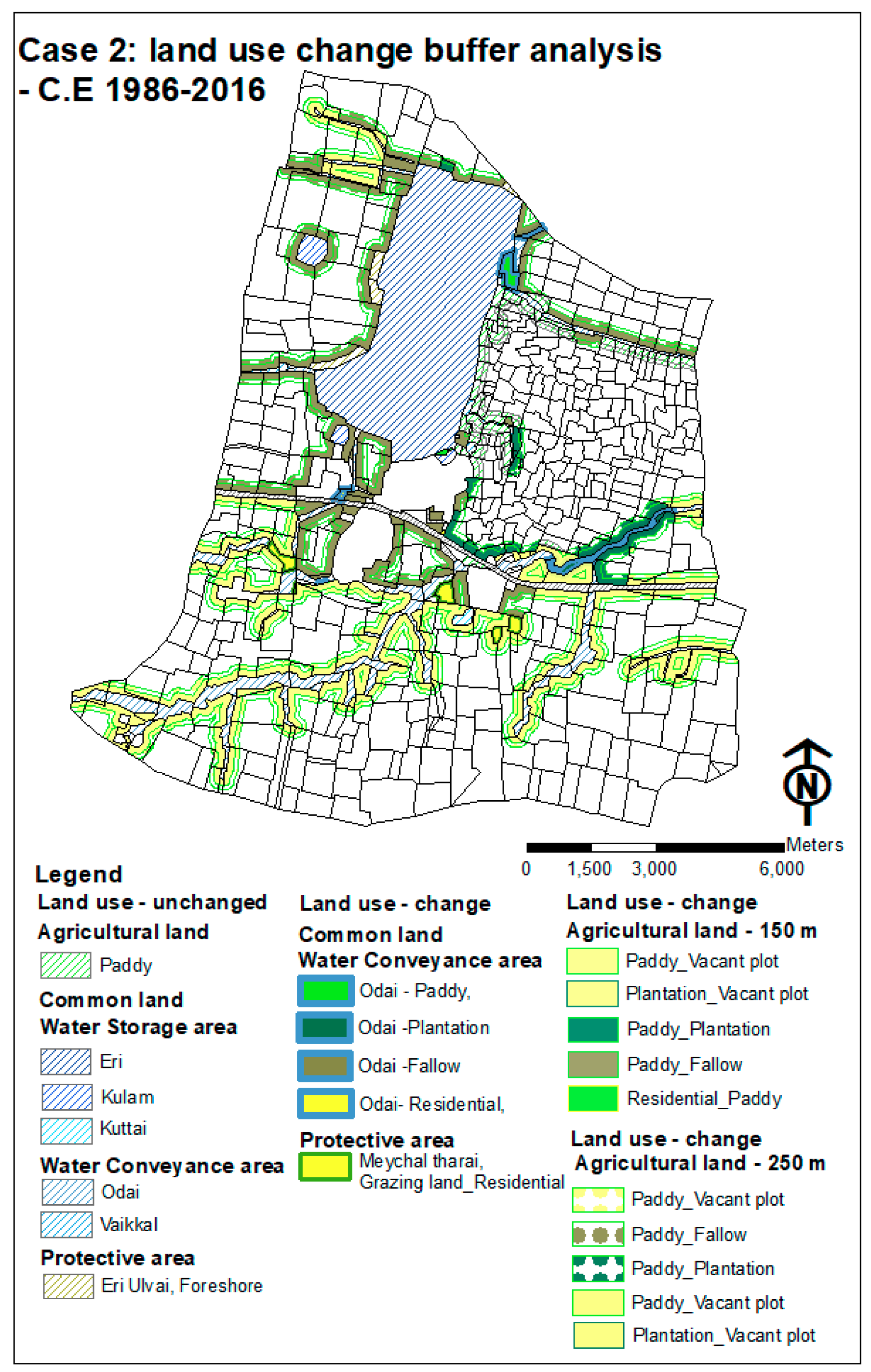
Appendix E
| No. | Survey No. | Name of the Tank | Type of the Tank | Control -Agency | Area (m2) | If Irrigation Tank | Purpose-Now | Purpose-Earlier | Activity | Frequency |
|---|---|---|---|---|---|---|---|---|---|---|
| I | Case 1: | |||||||||
| 1 | 116 | Un eri | Eri | P.W.D | 24,082.49 | yes | IRR | IRR | cultural activities around | high |
| 2 | 195 | Mevalurkuppameri | Eri | P.W.D | 748,668 | yes | IRR | IRR | agricultural and cultural activities around | high |
| 3 | 287 | Kattagaram Eri | Eri | Panchayat | 22,340.10 | yes | NO | IRR | no major activities around | low |
| 4 | 171 | Kulam 1 | Kulam | Panchayat | 981.79 | no | Wa | Wa | no major activities around | high |
| 5 | 249 | Kulam 2 | Kulam | Panchayat | 17,426.58 | no | Wa | Wa | no major activities around | na |
| 6 | 280 | Katan kulam | Kulam | Panchayat | 3336.10 | no | Wa | Wa | cultural activities around | high |
| 7 | 400 | Kannadiyanpalayamkulam | Kulam | Panchayat | 4387.92 | no | Wa | Wa | cultural activities at occasions | high |
| 8 | 14 | Kalkuttai | Kuttai | Panchayat | 2493.18 | no | Ca | Ca | cattle grazing | low |
| 9 | 38 | Kuttai 2 | Kuttai | Panchayat | 22,585.50 | yes | IRR | IRR | no major activities around | low |
| 10 | 40 | Easwarankoilkuttai | Kuttai | Panchayat | 3715.12 | no | NO | SA | cultural activities around | low |
| 11 | 126 | Arasankalanikuttai | Kuttai | Panchayat | 5,166.28 | no | Wa | Wa | no major activities around | high |
| 12 | 131 | Karpagaviyagarkoilkuttai | Kuttai | Panchayat | 4727.99 | no | SA | SA | cultural activities around | low |
| 13 | 234 | Kuttai 2 | Kuttai | Panchayat | 3454.64 | no | Wa | Wa | cultural activities around | festive seasons |
| 14 | 251 | Kakkukuttai | Kuttai | Panchayat | 8481.46 | no | Wa | SA | cultural activities around | low |
| 15 | 254 | Sudukattukuttai | Kuttai | Panchayat | 835.91 | no | Cr | Cr | cremation | very low |
| 16 | 421 | Sri Palliyaththamman koil kuttai | Kuttai | Panchayat | 1871.63 | no | SA | SA | cultural activities around | low |
| 17 | 4a | Papankalanikuttai | Kuttai | Panchayat | 4284.02 | yes | NO | Wa | no major activities around | very low |
| 18 | 23 | Thangal 1 | Thangal | Panchayat | 13,153.37 | yes | NO | IRR | no major activities around | very low |
| 19 | 45 | Sakaraithangal | Thangal | Panchayat | 2242.50 | no | Wa | Wa | no major activities around | low |
| 20 | 176 | Vannirthangal | Thangal | Panchayat | 15,518.53 | yes | IRR | IRR | no major activities around | low |
| 21 | 214 | Thangal1 | Thangal | Panchayat | 41,829.37 | yes | Dy | IRR | dumping waste and garbage | high |
| 22 | 401 | Konnerithangal | Thangal | Panchayat | 1997.63 | no | NO | Wa | dumping waste and garbage | low |
| II | CASE 2: | |||||||||
| 1 | 186 | Periyaeri | Eri | P.W.D. | 724,900 | Yes | Wa | IRR | ||
| 2 | 211 | Vannankulam | Kulam | Panchayat | 5637 | No | Wa | Wa | ||
| 3 | 254 | Nallathanikulam | Kulam | Panchayat | 11,133 | No | Dr | Dr | Fishing is prohibited for some time now | |
| 4, 5 | 331 | Kulam | Kulam | Panchayat | 10,292 | Yes | St | IRR | ||
| 6 | 367 | Mandhaivelikulam | Kulam | Panchayat | 2997 | Yes | Ca | IRR | ||
| 7 | 369 | Mandhaivelikulam | Kulam | Panchayat | 1366 | Yes | St | IRR | ||
| 8 | 490 | Kulam | Kulam | Panchayat | 1744 | Yes | St | IRR | ||
| 9 | 247/A | Annanagarkulam | Kulam | Panchayat | 1515 | No | Wa | Dr | ||
| 10 | 405, 289 | Nallathannikulam | Kulam | Panchayat | 10,075 | No | Dr | Dr | ||
| 11 | 497, 499 | New water body | Kulam | Panchayat | 5469 | No | Dr | Dr | ||
| 12 | 198 | Kuttai | Kuttai | Panchayat | 122 | Yes | St | IRR | ||
| 13 | 242 | Kuttai | Kuttai | Panchayat | 6361 | Yes | NO (Dry) | IRR | ||
| 14 | 254 | Kuttai | Kuttai | Panchayat | 2717 | Yes | St | IRR | ||
| 15 | 254 | Kuttai | Kuttai | Panchayat | 1858 | Yes | Gr | IRR | ||
| 16 | 254 | Kuttai | Kuttai | Panchayat | 1343 | Yes | Gr | IRR | ||
| 17 | 273 | Kuttai | Kuttai | Panchayat | 3293 | Yes | St | IRR | ||
| 18 | 415 | Kuttai | Kuttai | Panchayat | 12,594 | No | St | St | ||
| 19 | 182 b | Kuttai | Kuttai | Panchayat | 96,158.96 | Yes | St | IRR | ||
References
- McDonald, R.I. Water on an urban planet: Urbanization and the reach of urban water infrastructure. Glob. Environ. Chang. 2014, 27, 96–105. [Google Scholar] [CrossRef]
- Janakarajan, S.; Butterworth, J.; Moriarty, P.; Batchelor, C. Strengthened city, marginalised peri-urban villages: Stakeholder dialogues for inclusive urbanisation in Chennai, India. In Peri-Urban Waterconflicts-Supporting Dialogue and Negotiations; Technical Paper Series 50; Butterworth, J., Ducrot, R., Faysse, N., Janakarajan, S., Eds.; International Water Sanitation Centre: Delft, The Netherlands, 2007; pp. 51–75. [Google Scholar]
- Butterworth, J.; Warner, J. Introduction. In Peri-Urban Waterconflicts-Supporting Dialogue and Negotiations; Technical Paper Series 50; Butterworth, J., Ducrot, R., Faysse, N., Janakarajan, S., Eds.; International Water Sanitation Centre: Delft, The Netherlands, 2007; pp. 8–23. [Google Scholar]
- Balasubramanian, R.; Choi, S.C. Urbanisation, population pressure and agricultural intensification: Evidences from Tamilnadu, India. J. Rural Dev. 2010, 33, 87–108. [Google Scholar]
- Wade, R. Village Republics: Economic Conditions for Collective Action in South India; ICS Press, Institute for Contemporary Studies: San Fransico, CA, USA, 1994. [Google Scholar]
- Grafton, R.Q. Governance of the commons: A role for the state? Land Econ. 2000, 76, 504–517. [Google Scholar] [CrossRef]
- Aubriot, O.; Prabhakar, P. Ignatius. Water Institutions and the ‘Revival’ of tanks in South India: What is at stake locally. Water Altern. 2011, 4, 325–346. [Google Scholar]
- Gomes, S.; Hermans, L.; Islam, K.; Huda, S.; Hossain, A.T.; Thissen, W. Capacity building for water management in peri-urban communities, Bangladesh: A simulation-gaming approach. Water 2018, 10, 1704. [Google Scholar] [CrossRef]
- Alamanos, A.; Mylopoulos, N.; Loukas, A.; Gaitanaros, D. An integrated multicriteria analysis tool for evaluating water resource management strategies. Water 2018, 10, 1795. [Google Scholar] [CrossRef]
- Delgado-Serrano, M.M.; Ramos, P.A.; Zapata, E.L. Using Ostrom’s DPs as fuzzy sets to analyze how water policies challenge community-based water governance in Colombia. Water 2017, 9, 535. [Google Scholar] [CrossRef]
- Agarwal, A.; Narain, S. Dying Wisdom: Rise, Fall and Potential of India’s Traditional Water Harvesting Systems (State of India’s Environment, Volume 4); CSE: New Delhi, India, 1997. [Google Scholar]
- Ariza, P.; Galan, E.; Serranao, T. Water Tank as Ecosystems—Ecosystemic Perception of Local Population for Integral Management of Water Tanks in Tamilnadu, South India. Master Thesis, Ciencias Ambientales, Universitat Autonoma de Barcelona, Barcelona, Spain, 2007. [Google Scholar]
- Ratnavel, S.M.; Gomathinayagam, P. Search If Ancient Wisdom—Irrigation Tanks; DHAN Foundation: Madurai, India, 2006. [Google Scholar]
- Ramasamy, S. Law, Technology and Water Conflicts in Developing Societies: A Case Study of Tank Systems in Tamilnadu. Ph.D. Thesis, Faculty of Social Sciences and Humanities, University of Westminster, London, UK, 2014. [Google Scholar]
- Elumalai, G. Institutional reforms, support and policy issues for development and management of small village tanks in Tamilnadu. In Village Tanks of South Asia; DHAN Foundation: Madurai, India, 2002; pp. 138–142. [Google Scholar]
- Arumugam, N.; Mohan, S.; Ramprasad, R. Sustainable developement and management of Tank irrigation systems in South India. Water Int. 1997, 22, 90–97. [Google Scholar] [CrossRef]
- Vaidyanathan, A.; Sivasubramaniyan, K. Tank irrigation in South India: An Overview. In Tanks of South India; Vaidyanathan, A., Ed.; Centre for Science and Environment: New Delhi, India, 2001; pp. 5–28. [Google Scholar]
- Mukundan, T.M. The Ery systems of South India; Akash Ganga Trust: Chennai, India, 2005. [Google Scholar]
- Rukkumany, R.H.; Vedamuthu, R. Storing monsoon waters: The tank systems of Tamilnadu. In Monsoon Assemblages; Monsoon Waters: London, UK, 2019; pp. 210–221. [Google Scholar]
- Mizushima, T. Mirasi system and local society in Pre-colonial South India. In Local Agarian Societies in Colonial India-Japanese Perspectives; Robb, P., Sugihara, K., Yanagisawa, H., Eds.; Routledge, Taylor and Francis Group: London, UK, 1996. [Google Scholar]
- Mosse, D. The Rule of Water: Statecraft, Ecology and Collective Action in South India; Madhav, G., Ramachandra, G., Eds.; Oxford University Press: New Delhi, India, 2003. [Google Scholar]
- Sivasubramaniyan, K.; Vaidyanathan, A. Tanks of Periyar Vaigai basin. In Tanks of South India; Vaidyanathan, A., Ed.; Centre for Science and Environment: New Delhi, India, 2001; pp. 31–54. [Google Scholar]
- Vaidyanathan, A. Conclusions and implications. In Tanks of South India; Vaidyanathan, A., Ed.; Centre for Science and Environmen: New Delhi, India, 2001; pp. 155–162. [Google Scholar]
- Naz, F.; Subramanian, S. Water Managment across Space and Time in India; ZEF Working Paper Series; Department of Political and Cultural Change, Center for Development Research, University of Bonn: Bonn, Germany, 2010; Volume 61, pp. 1–32. [Google Scholar]
- Oppen, M.V.; Subba Rao, K.V. Tank Irrigation in Semi-Arid Tropical India Economic Evaluation and Alternatives for Improvement; International Crops Research Institute for the Semi-Arid Tropics: Patancheru, Andhra Pradesh, India, 1987; pp. 1–42. [Google Scholar]
- Rodrigo, G. Water, Water, Nowhere: A Case Study of Palayaseevaram Village Regarding Sharing of Water with the Chennai City and Its Impact on the Village; WHIRL Project Working Paper; Natural Resources Institute, University of Greenwich: Chatham, UK, 2004; Volume 9, pp. 1–23. [Google Scholar]
- Shah, E. Social Designs: Tank Irrigation Technology and Agarian Transformation in South India; Wageningen University Water Resources Series Orient Longman: New Delhi, India, 2003; Volume 4. [Google Scholar]
- Janssen, M.A.; Anderies, J.M. Robustness Trade-offs in Social Ecological Systems. Int. J. Commons 2007, 1, 43–65. [Google Scholar] [CrossRef]
- Nagendra, H.; Elinor, O. Applying the social-ecological system framework to the diagnosis of urban lake commons in Bangalore, India. Ecol. Soc. 2014, 19, 1–8. [Google Scholar] [CrossRef]
- Sanchayan, N. Ownership and outcomes: The case of Lakes and Wetlands in India. In Workshop in Political Theory and Policy Analysis; Indiana University: Bloomington, Indiana, 2012. [Google Scholar]
- Yanagisawa, H. Village common land, manure, fodder, and intensive agricultural practices in Tamilnadu from mid-nineteenth century. Rev. Agrar. Stud. 2011, 1, 23–42. [Google Scholar]
- Dhatchayani, S.; Arul, C.; Ambujam, N.K. Impact of urbanization on landuse in a peri-urban, Chennai—A case study of catchment and command area of Chemberabakkam tank. Int. J. Eng. Sci. Technol. 2013, 5, 182–194. [Google Scholar]
- Lavanya, K. Urban Flood Management—A case study of Chennai city. Arch. Res. 2012, 2, 115–121. [Google Scholar] [CrossRef]
- Sethuram, S. Case study: Water management issues in Chennai, India. Univ. J. Environ. Res. Technol. 2014, 4, 299–306. [Google Scholar]
- Anuradha, B.; Rajeswari, M.; Ambujam, N.K. Socio-economic impact of irrigation tank restoration on livelihood options in Peri-urban and rural areas. In Proceedings of the International Conference on Economics, Social Sciences and Languages (ICESL), Singapore, 14–15 May 2014; pp. 67–71. [Google Scholar]
- Chennai Metropolitan Developement Authority. Chapter I: Introduction. In Second Master Plan for Chennai 2026; Chennai Metropolitan Developement Authority: Chennai, India. Available online: www.cmdachennai.gov.in/volume1.html (accessed on 15 December 2017).
- Ramesh, S.; Nagarajan, N.; Poongothai, S. Land use in suburbia: Perungalathuur village of Chennai metropolitan area. Int. J. Sci. Eng. Res. 2011, 4, 1–6. [Google Scholar]
- Du, X.; Jin, X.; Yang, X.; Yang, X.; Zhou, Y. Spatial pattern of land use change and its driving force in Jiangsu Province. Int. J. Environ. Public Health 2014, 11, 3215–3232. [Google Scholar] [CrossRef]
- Ainiwaer, M.; Ding, J.; Wang, J.; Nasierding, N. Spatiotemporal dynamics of water table depth associated with changing agricultural land use in an arid-zone oasis. Water 2019, 11, 673. [Google Scholar] [CrossRef]
- Department of Town and Country Planning. Information Handbook under the Right to Information Act; DTCP: Chennai, India, 2005; pp. 29–43. [Google Scholar]
- Venkatasubramaniam, G.; Van Klink, I.; Richard-Ferroudji, A. Scenarios for Water and Agriculture in the Pondicherry Region; Project Report; French Institute of Pondicherry: Pondicherry, India, 2017. [Google Scholar]
- Horn, S. Using a GIS to Determine How Different Types of Land Cover Have Changed over Time in the State of Connecticut; Papers in Resource Analysis; Saint Mary’s University of Minnesota Central Services Press: Winona, MN, USA, 2010; Volume 12, pp. 1–11. [Google Scholar]
- Creswell, J.W. The selection of Research Design. In Research Design: Qualitatice, Quantitative, and Mixed Method Approaches, 3rd ed.; SAGE Publications: New Delhi, India, 2009; Volume 1, pp. 3–23. [Google Scholar]
- Wang, J.; Gao, Y.; Wang, S. Land use/cover change impacts on water table change over 25 years in a desert-oasis transition zone of the Heihe river basin, China. Water 2015, 8, 11. [Google Scholar] [CrossRef]
- Kumar, P.; Dasgupta, R.; Johnson, B.A.; Saraswat, C.; Basu, M.; Kefi, M.; Mishra, B.K. Effect of land use changes on water quality in an ephemeral coastal plain: Khambat city, Gujrat, India. Water 2019, 11, 724. [Google Scholar] [CrossRef]
- Ding, J.; Jiang, Y.; Fu, L.; Liu, Q.; Peng, Q.; Kang, M. Impacts of land use on surface water quality in a subtropical River Basin: A case study of the Dongjiang River Basin, Southeastern China. Water 2015, 7, 4427–4445. [Google Scholar] [CrossRef]
- Bossa, A.Y.; Diekkrugar, B.; Agbossou, E.K. Scenario-based impacts of land use and climate change on land and water degradation from the meso to regional scale. Water 2014, 6, 3152–3181. [Google Scholar] [CrossRef]
- Pinto, P.J.; Kondolf, G. Evolution of two urbanized estuaries: Environmental change, legal framework and implications for sea-level rise vulnerability. Water 2016, 8, 535. [Google Scholar] [CrossRef]
- Lindberg, S.; Rajagopal, A.; Djurfeldt, G.; Athreya, V.B.; Vidyasagar, R. Designing collective action: Problems of local water management in Tiruchi district. Rev. Agrar. Stud. 2011, 1, 157–178. [Google Scholar]
- La Vanchy, G.T.; Romano, S.T.; Taylor, M.J. Challenges to water security along the “Emerald coast”: A political ecology of local water governance in Nicaragua. Water 2017, 9, 655. [Google Scholar] [CrossRef]




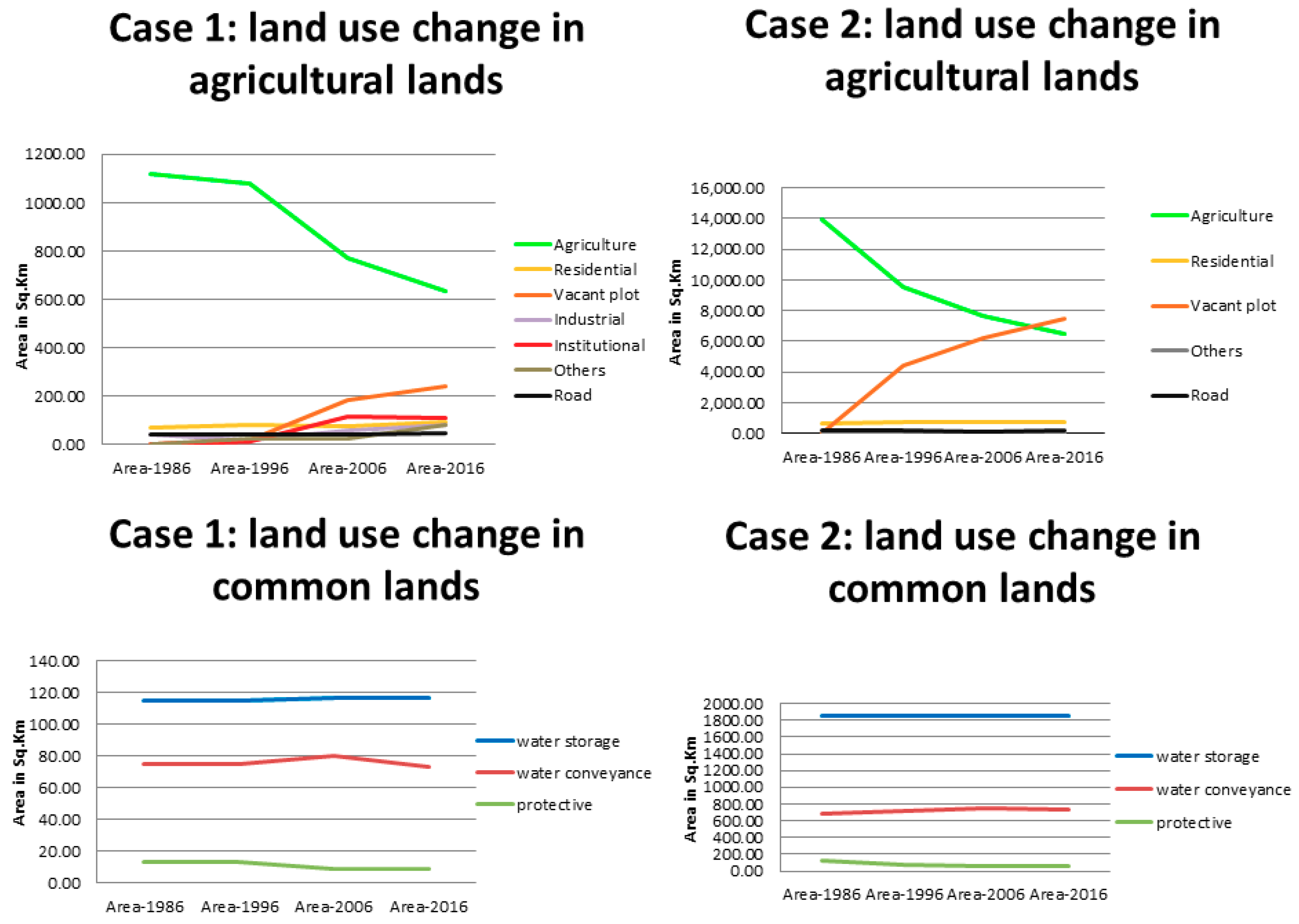








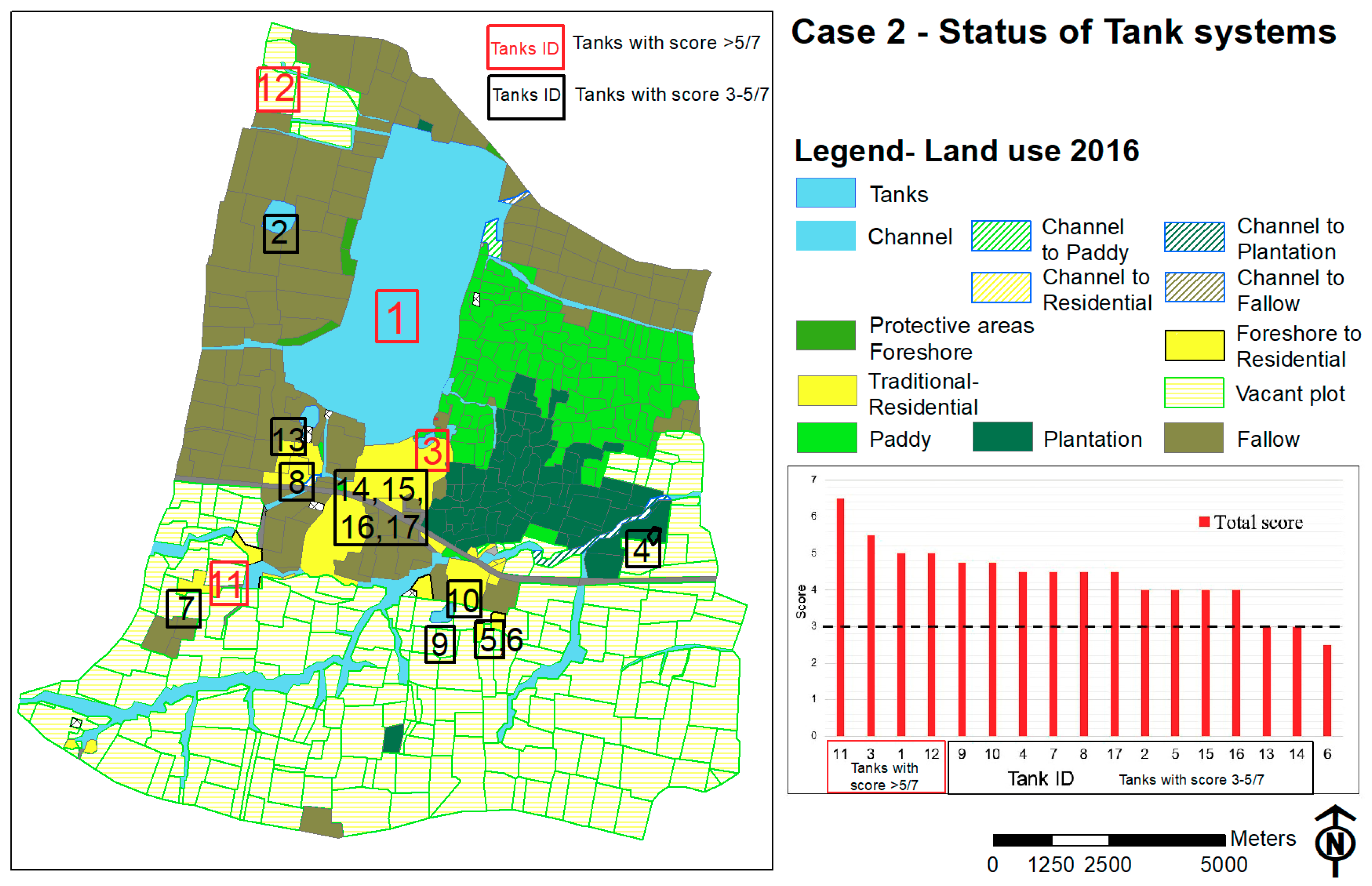
| Case 1 | ||||||
|---|---|---|---|---|---|---|
| Land Use Type | Area-1986 km2 | Area-2016 km2 | Change in Area (1986–2016) km2 | Total % of Land Changed (1986–2016) | % of total Area in 1986 | % of total Area in 2016 |
| Fallow | 5.61 | 5.13 | −0.48 | −8.53 | 37.81 | 34.59 |
| Paddy | 4.27 | 0.62 | −3.66 | −85.56 | 28.80 | 4.16 |
| Plantation | 1.30 | 0.58 | −0.72 | −55.62 | 8.79 | 3.90 |
| Total agriculture | 11.18 | 6.33 | −4.86 | −43.44 | 75.40 | 42.65 |
| Residential | 7.16 | 0.91 | 0.19 | 27.02 | 4.83 | 6.13 |
| Vacant plot | 0.03 | 2.42 | 2.39 | 8278.66 | 0.19 | 16.29 |
| Industrial | 0.41 | 0.82 | 0.41 | 98.30 | 2.80 | 5.55 |
| Institutional | 0.00 | 1.10 | 1.10 | 100.00 | 0.00 | 7.41 |
| Others | 0.01 | 0.80 | 0.79 | 9371.05 | 0.06 | 5.40 |
| Water Storage areas | 1.17 | 1.15 | −0.02 | −1.60 | 7.87 | 7.74 |
| Water Conveyance areas | 0.75 | 0.73 | −0.02 | −2.47 | 5.06 | 4.93 |
| Protective areas | 0.13 | 0.08 | −0.05 | −36.04 | 0.87 | 0.56 |
| Total land area in the village | 14.83 | 14.83 | ||||
| Case 2 | ||||||
| Fallow | 0 | 38.25 | 38.25 | 100.00 | 0.00 | 21.89 |
| Paddy | 139.49 | 15.30 | −124.20 | −89.03 | 79.84 | 8.75 |
| Plantation | 0.06 | 11.01 | 10.95 | 19716.10 | 0.03 | 6.30 |
| Total agriculture | 139.55 | 64.55 | −75.00 | −53.74 | 79.87 | 36.94 |
| Residential | 6.79 | 7.26 | 0.48 | 7.04 | 3.88 | 4.16 |
| Vacant plot | 0 | 74.45 | 74.45 | 100.00 | 0.00 | 42.61 |
| Others | 0.03 | 0.03 | 0.01 | 21.17 | 0.01 | 0.02 |
| Water Storage areas | 18.61 | 18.61 | 0.00 | 0.00 | 10.65 | 10.65 |
| Water Conveyance areas | 6.81 | 7.30 | 0.48 | 7.11 | 3.90 | 4.18 |
| Protective areas | 1.16 | 0.65 | −0.51 | −43.85 | 0.66 | 0.37 |
| Total land area in the village | 174.72 | 174.72 | ||||
| Land Use Classification as Per the Regulations of the Department of Town and Country Planning, Government of Tamilnadu | Land Use Classification followed in this Research |
|---|---|
| Residential use zone | Divided into two classifications—1. Vacant plot, 2. Residential |
| Commercial use zone | As this category of land use was very limited in the study area and was merged with land uses that are different from the categories given in this table and classified as Others. |
| Industrial use zone | Industrial |
| Educational use zone | Institutional |
| Public and semipublic use zone | Common lands |
| Agricultural use zone | Divided into three classifications (1) Paddy. (2) Plantation. (3) Fallow. |
| Correlation Values | ||||||||
|---|---|---|---|---|---|---|---|---|
| Change in Common Lands Related to Water Management | Change in the Total Land under Agricultural Land Use | Change in the Total Land under Fallow | Change in the Total Land under Paddy | Change in the Total Land under Plantation | ||||
| Case 1 | Case 2 | Case 1 | Case 2 | Case 1 | Case 2 | Case 1 | Case 2 | |
| Water storage areas | 0.96 | No change in water storage areas | 0.74 | No change in water storage areas | 0.86 | No change in water storage areas | 0.21 | No change in water storage areas |
| Water conveyance areas | 0.05 | 0.91 | 0.79 | 0.48 | 0.21 | 0.87 | 0.99 | 0.66 |
| Protective areas | 0.97 | 0.58 | 0.72 | 0.50 | 0.89 | 0.96 | 0.22 | 0.22 |
© 2019 by the authors. Licensee MDPI, Basel, Switzerland. This article is an open access article distributed under the terms and conditions of the Creative Commons Attribution (CC BY) license (http://creativecommons.org/licenses/by/4.0/).
Share and Cite
R. Harishankar, R.; Vedamuthu, R. Evaluating the Functioning Mechanisms of ‘TANK Systems’ in Peri-Urban Areas of Chennai, India—Land Use Change as the Determinant. Water 2019, 11, 1219. https://doi.org/10.3390/w11061219
R. Harishankar R, Vedamuthu R. Evaluating the Functioning Mechanisms of ‘TANK Systems’ in Peri-Urban Areas of Chennai, India—Land Use Change as the Determinant. Water. 2019; 11(6):1219. https://doi.org/10.3390/w11061219
Chicago/Turabian StyleR. Harishankar, Rukkumany, and Ranee Vedamuthu. 2019. "Evaluating the Functioning Mechanisms of ‘TANK Systems’ in Peri-Urban Areas of Chennai, India—Land Use Change as the Determinant" Water 11, no. 6: 1219. https://doi.org/10.3390/w11061219
APA StyleR. Harishankar, R., & Vedamuthu, R. (2019). Evaluating the Functioning Mechanisms of ‘TANK Systems’ in Peri-Urban Areas of Chennai, India—Land Use Change as the Determinant. Water, 11(6), 1219. https://doi.org/10.3390/w11061219




